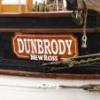-
Posts
3,084 -
Joined
-
Last visited
Reputation Activity
-
 Jaager got a reaction from jud in Trying to identify an inherited solid hulled model
Jaager got a reaction from jud in Trying to identify an inherited solid hulled model
I also think it is 1850's vintage.
With the purpose of starting a discussion, I make some observations based on little evidence:
The masts and yards seem to be over scale.
The hull lines look clipper-like, but with only topgallants on all three masts, it is more like a coastal packet.
I see no evidence of deck hatches, how would she carry any cargo?
The forecastle and catheads look twice as large - like the hull is 1/8" scale and they are 1/4" scale.
The bulwark height does not match scale with deckhouse size.
Scientific kits had pre-made shrouds with ratlines, but you would be better served mounting the shrouds individually and doing the ratlines in place.
This may not be a kit at all and not made from plans of a real vessel.
-
 Jaager got a reaction from hornet in double planking a hull
Jaager got a reaction from hornet in double planking a hull
In most POB kits, the spacing of the body moulds are too far apart to support a thin single run of planking. A first layer of what looks to be poor quality wood (open pore, course grain, easy to splinter) is supposed to provide what is essentially a simulation of a solid hull to receive the layer of outer planking. Even with this, it would be useful to glue laminations of veneer to the inside of the first layer (perpendicular to the run of planking)(at a scale width of 6-12 inches)(laminate in place) to receive the treenails of the actual planking. Before the mid 17th century (at least) the futtocks were fit to the inside of the planking instead of the reverse later.
If you wish a single layer:
the actual planks would probably need to be thicker than what is provided.
the space between the moulds should have support material (at the least 50% wood with the open space not wide).
-
 Jaager got a reaction from dgbot in Another rookie question - Can I Clean Up the Keel With A Dremel
Jaager got a reaction from dgbot in Another rookie question - Can I Clean Up the Keel With A Dremel
Other tools to try : a small hand plane - needle files.
-
 Jaager got a reaction from hornet in Another rookie question - Can I Clean Up the Keel With A Dremel
Jaager got a reaction from hornet in Another rookie question - Can I Clean Up the Keel With A Dremel
Other tools to try : a small hand plane - needle files.
-
 Jaager got a reaction from jud in In need of very thin steel wire (0.010 inch or less)
Jaager got a reaction from jud in In need of very thin steel wire (0.010 inch or less)
There is another way:
Start with one size of brass or copper wire.
Use a draw plate to get whichever smaller diameter that you need.
We may use draw plates to make bamboo or wooded treenails, but the original purpose is to make wire.
-
 Jaager got a reaction from mtaylor in In need of very thin steel wire (0.010 inch or less)
Jaager got a reaction from mtaylor in In need of very thin steel wire (0.010 inch or less)
There is another way:
Start with one size of brass or copper wire.
Use a draw plate to get whichever smaller diameter that you need.
We may use draw plates to make bamboo or wooded treenails, but the original purpose is to make wire.
-
 Jaager got a reaction from qwerty2008 in bandsaw questions
Jaager got a reaction from qwerty2008 in bandsaw questions
You need blade tension to be what is recommended and no tighter. Tighter will not stop wander, but it will shorten the life of your blade.
Make sure that you take the tension off of your blade when you are done for the day.
Here is a resawing guide: http://www.highlandwoodworking.com/library/Slicing%20Wood.pdf
-
 Jaager got a reaction from AON in bandsaw questions
Jaager got a reaction from AON in bandsaw questions
You need blade tension to be what is recommended and no tighter. Tighter will not stop wander, but it will shorten the life of your blade.
Make sure that you take the tension off of your blade when you are done for the day.
Here is a resawing guide: http://www.highlandwoodworking.com/library/Slicing%20Wood.pdf
-
 Jaager got a reaction from grsjax in choices other than boxwood or swiss pear?
Jaager got a reaction from grsjax in choices other than boxwood or swiss pear?
From your list, my favorites are also the least expensive:
Rock Maple (Acer saccharum)
Black Cherry (Prunus serotina)
Both hard, tight grain with low contrast, closed pore.
See if there are any hardwood saw mills in your area.
If you can harvest your own, look for
Apple
Bradford Pear
Other fruit wood - Crab Apple, Pear, Plum
Dogwood
Washington Hawthorn
Holly is good, but very tricky - harvest in Winter and kiln dry quickly - otherwise Blue Mold will ruin it.
I do not think Peach is any good
-
 Jaager got a reaction from CharlieZardoz in Cutting into a solid hull to make a cabin space for Sultana
Jaager got a reaction from CharlieZardoz in Cutting into a solid hull to make a cabin space for Sultana
If you are going to detail the interior, you could give some consideration to doing the hull POF.
-
 Jaager got a reaction from WackoWolf in how to determine the correct number of frames on scratchbuilt ship (Moved by moderator)
Jaager got a reaction from WackoWolf in how to determine the correct number of frames on scratchbuilt ship (Moved by moderator)
The following book should answer your questions:
This is not an endorsement of the vendor, just the book: http://www.amazon.com/American-Built-Clipper-Ship-1850-1856-Characteristics/dp/0071358234/ref=pd_sim_sbs_b_3?ie=UTF8&refRID=149PENCFDSR2QBC446BM
Maybe not - I misread your vessel as Wm Webb's Young America, a clipper.
-
 Jaager got a reaction from tasmanian in Band Saw
Jaager got a reaction from tasmanian in Band Saw
The common size for benchtop bandsaws seems to be 9 inch. There are many models available. You may not be happy with one smaller than this. Check your big box hardware outlets and on line for this size. With a strong enough motor, you should be able to resaw from 2 inch stock. If you are going to use it to cut out patterns, you can cut tight turns with a 1/8" blade. I was disappointed when the 1/16" blades were discontinued. If scroll cutting is to be your main purpose, you might wish to look at Carter Products -Band Saw Stabilizer® Guide System for Scroll Cutting. If it looks like something you would use, buy a 9 inch bandsaw that will match one of the available stabilizer models. Over here, 59 1/2" is the common blade size for a 9 inch saw. It is probably wise to pick a model that uses a readily availble blade size.
Since a bandsaw cuts in a constant downward direction, there is no vibration or chatter of a work piece as with a scroll saw or jigsaw.
Some models may be noisy, but most probably are not. The issue is probably moot, since you would not hear it over the noise from the shopvac collecting the wood dust anyway.
-
 Jaager got a reaction from GLakie in Ordering wood to plank ....how much to order
Jaager got a reaction from GLakie in Ordering wood to plank ....how much to order
For the Holly, you would need to factor in the kerf if you cut your own from a sheet, but you would be able to match the width to that of each vessel. Being a bit compulsive, I would order twice the amount I calculate as needed.
For the Pear, with a sheet, you may be able to get more efficient use of the wood since you should be spilling the plank shapes. You may be able to use the curve from a previous plank as the edge of the current one.
Spilling = cut a piece of 3x5 or 4x6 index card to the shape that will fill the plank opening without any lateral bends - so that it lays in naturally. Not often will it be a true rectangle. More likely sort of parallel shallow curves, but the width tends to taper a bit. Use the card board pattern to cut the planks for each side. One hopes that bilateral symmetry is occuring, but adjustments as you go should correct a digression while it is minor. If you calculate (say) six stakes between a pair of ribbands, rather than cutting all six, measure 1/6 th for the first, lay it in, measure 1/5 th for the next, etc.
-
 Jaager got a reaction from NMBROOK in The use of Applewood in modelling?
Jaager got a reaction from NMBROOK in The use of Applewood in modelling?
Pro:
Debarking will speed drying.
You will discover any boring insects or remove any eggs if they have not hatched yet.
Con:
It is possible that it may dry too quickly and unevenly and check or split - I suspect this is mostly a problem with thick pieces of wood in log form.
-
 Jaager got a reaction from GLakie in Boxwood question
Jaager got a reaction from GLakie in Boxwood question
A table saw is not necessarily your best tool. Your bandsaw is better. But you probably also will want a thickness sander.
Your wood is essentially seasoned. You need to get it into flat from the round.
1) If you band saw is large enough, you will not be sorry for using this blade: http://www.highlandwoodworking.com/woodslicer12resawbandsawblades705to137.aspx?utm_source=iContact&utm_medium=email&utm_campaign=Wood%20News&utm_content=THW+5 - but only use it for resawing - which is what you will be doing.
2) You need to fix the log to a carrier board to keep it from rolling. The board needs to be flat and have one straight edge - to ride against the fence. An easy way to fix the log - use right angle 2x4 braces from a big box building supply place and wood screws - one on each end of the log and at least one on the back side. Having room for this pretty much tells you how large the carrier board has to be. You can use short screws to attach the braces to the board, so 1/2 inch ply might do, but 3/4 inch is probably better.
3) The size you produce - it depends. If you have an immediate need, that is your thickness. Otherwise - decide on a raw stock size to slice your your final planks from. I like 1 to1.5 inch thick - as wide as I can get.
The Wood Slicer blade cuts a thinner kerf than most table saw blades and the finish is almost as smooth as what a hollow ground table saw produces. You are also less likely to get unwanted digit amputation with a band saw. A thickness sander is also safer way to get thickness precision. It is probably a toss up between a Byrnes saw and the band saw for cutting the final width of deck planks. For hull planks - if you do them correctly - the final width will come from your table sander - since there is spilling involved. We are not building a house, most everything is curved.
Now that you have a band saw, look at this for turning it into a stable jig saw. http://www.carterproducts.com/band-saw-products/band-saw-stabilizer
-
 Jaager got a reaction from GLakie in Boxwood question
Jaager got a reaction from GLakie in Boxwood question
For resawing, it is not the number of teeth that counts. 3 teeth per inch will do. The Wood Slicer is thinner, has stronger steel and the teeth have almost no set. The key is the tooth shape - it is technical. A fine tooth blade will probably have too much set and not be efficient in wood removal thru thick stock. The gullet will fill with sawdust before it get thru the wood and stop cutting. The set will leave a rough surface. Look for a blade designed for resawing.
-
 Jaager got a reaction from WackoWolf in Boxwood question
Jaager got a reaction from WackoWolf in Boxwood question
For resawing, it is not the number of teeth that counts. 3 teeth per inch will do. The Wood Slicer is thinner, has stronger steel and the teeth have almost no set. The key is the tooth shape - it is technical. A fine tooth blade will probably have too much set and not be efficient in wood removal thru thick stock. The gullet will fill with sawdust before it get thru the wood and stop cutting. The set will leave a rough surface. Look for a blade designed for resawing.
-
 Jaager got a reaction from michael mott in Boxwood question
Jaager got a reaction from michael mott in Boxwood question
For resawing, it is not the number of teeth that counts. 3 teeth per inch will do. The Wood Slicer is thinner, has stronger steel and the teeth have almost no set. The key is the tooth shape - it is technical. A fine tooth blade will probably have too much set and not be efficient in wood removal thru thick stock. The gullet will fill with sawdust before it get thru the wood and stop cutting. The set will leave a rough surface. Look for a blade designed for resawing.
-
 Jaager got a reaction from mtaylor in Boxwood question
Jaager got a reaction from mtaylor in Boxwood question
For resawing, it is not the number of teeth that counts. 3 teeth per inch will do. The Wood Slicer is thinner, has stronger steel and the teeth have almost no set. The key is the tooth shape - it is technical. A fine tooth blade will probably have too much set and not be efficient in wood removal thru thick stock. The gullet will fill with sawdust before it get thru the wood and stop cutting. The set will leave a rough surface. Look for a blade designed for resawing.
-
 Jaager got a reaction from hornet in Boxwood question
Jaager got a reaction from hornet in Boxwood question
For resawing, it is not the number of teeth that counts. 3 teeth per inch will do. The Wood Slicer is thinner, has stronger steel and the teeth have almost no set. The key is the tooth shape - it is technical. A fine tooth blade will probably have too much set and not be efficient in wood removal thru thick stock. The gullet will fill with sawdust before it get thru the wood and stop cutting. The set will leave a rough surface. Look for a blade designed for resawing.
-
 Jaager got a reaction from DaveBaxt in Clear Shellac Sanding Sealer
Jaager got a reaction from DaveBaxt in Clear Shellac Sanding Sealer
I think of sanding sealer as being a thick product. Useful on open pore wood like Black Walnut, Oak, and A finish plywood to fill the pores and give a smooth even finish. Intended more for full size furiture.
Shellac is an excellent traditional finish. It can be as thick or thin as you wish. It is not good for applications where it can come in contact with water. It hydrates and turns white. It can be easily repaired, but do not use it to finish a coffee table.
A shellac finish can be removed with alcohol.
The material can be preextracted and purified and comes as Orange (probably straight from the beetle) to Super Blonde - almost water clear. The solvent is alcohol (methyl, ethyl, 2-propanol, probably propanol if you can find it). You can buy it in flakes and make up your own solution as needed. The more purified are the flakes, the lower the maximium concentration you can make. The impurities increase solubilitiy in alcohol. The more volatile is the alcohol (Me>Ethyl>Prop) the less working time if you are using a cloth for application. Dilute shellac is a good first coat for most any other finish. It is very compatible with other finishes. French polish seems to be multiple layers of shellac applied with a cloth that has a bit of Linseed oil in the cloth. I would guess that Tung oil or Walnut oil might work as well.
-
 Jaager got a reaction from Estoy_Listo in Clear Shellac Sanding Sealer
Jaager got a reaction from Estoy_Listo in Clear Shellac Sanding Sealer
I think of sanding sealer as being a thick product. Useful on open pore wood like Black Walnut, Oak, and A finish plywood to fill the pores and give a smooth even finish. Intended more for full size furiture.
Shellac is an excellent traditional finish. It can be as thick or thin as you wish. It is not good for applications where it can come in contact with water. It hydrates and turns white. It can be easily repaired, but do not use it to finish a coffee table.
A shellac finish can be removed with alcohol.
The material can be preextracted and purified and comes as Orange (probably straight from the beetle) to Super Blonde - almost water clear. The solvent is alcohol (methyl, ethyl, 2-propanol, probably propanol if you can find it). You can buy it in flakes and make up your own solution as needed. The more purified are the flakes, the lower the maximium concentration you can make. The impurities increase solubilitiy in alcohol. The more volatile is the alcohol (Me>Ethyl>Prop) the less working time if you are using a cloth for application. Dilute shellac is a good first coat for most any other finish. It is very compatible with other finishes. French polish seems to be multiple layers of shellac applied with a cloth that has a bit of Linseed oil in the cloth. I would guess that Tung oil or Walnut oil might work as well.
-
 Jaager got a reaction from src in Clear Shellac Sanding Sealer
Jaager got a reaction from src in Clear Shellac Sanding Sealer
I think of sanding sealer as being a thick product. Useful on open pore wood like Black Walnut, Oak, and A finish plywood to fill the pores and give a smooth even finish. Intended more for full size furiture.
Shellac is an excellent traditional finish. It can be as thick or thin as you wish. It is not good for applications where it can come in contact with water. It hydrates and turns white. It can be easily repaired, but do not use it to finish a coffee table.
A shellac finish can be removed with alcohol.
The material can be preextracted and purified and comes as Orange (probably straight from the beetle) to Super Blonde - almost water clear. The solvent is alcohol (methyl, ethyl, 2-propanol, probably propanol if you can find it). You can buy it in flakes and make up your own solution as needed. The more purified are the flakes, the lower the maximium concentration you can make. The impurities increase solubilitiy in alcohol. The more volatile is the alcohol (Me>Ethyl>Prop) the less working time if you are using a cloth for application. Dilute shellac is a good first coat for most any other finish. It is very compatible with other finishes. French polish seems to be multiple layers of shellac applied with a cloth that has a bit of Linseed oil in the cloth. I would guess that Tung oil or Walnut oil might work as well.
-
 Jaager got a reaction from Bill Hime in Clear Shellac Sanding Sealer
Jaager got a reaction from Bill Hime in Clear Shellac Sanding Sealer
I think of sanding sealer as being a thick product. Useful on open pore wood like Black Walnut, Oak, and A finish plywood to fill the pores and give a smooth even finish. Intended more for full size furiture.
Shellac is an excellent traditional finish. It can be as thick or thin as you wish. It is not good for applications where it can come in contact with water. It hydrates and turns white. It can be easily repaired, but do not use it to finish a coffee table.
A shellac finish can be removed with alcohol.
The material can be preextracted and purified and comes as Orange (probably straight from the beetle) to Super Blonde - almost water clear. The solvent is alcohol (methyl, ethyl, 2-propanol, probably propanol if you can find it). You can buy it in flakes and make up your own solution as needed. The more purified are the flakes, the lower the maximium concentration you can make. The impurities increase solubilitiy in alcohol. The more volatile is the alcohol (Me>Ethyl>Prop) the less working time if you are using a cloth for application. Dilute shellac is a good first coat for most any other finish. It is very compatible with other finishes. French polish seems to be multiple layers of shellac applied with a cloth that has a bit of Linseed oil in the cloth. I would guess that Tung oil or Walnut oil might work as well.
-
 Jaager got a reaction from Mahuna in Band Saw
Jaager got a reaction from Mahuna in Band Saw
The common size for benchtop bandsaws seems to be 9 inch. There are many models available. You may not be happy with one smaller than this. Check your big box hardware outlets and on line for this size. With a strong enough motor, you should be able to resaw from 2 inch stock. If you are going to use it to cut out patterns, you can cut tight turns with a 1/8" blade. I was disappointed when the 1/16" blades were discontinued. If scroll cutting is to be your main purpose, you might wish to look at Carter Products -Band Saw Stabilizer® Guide System for Scroll Cutting. If it looks like something you would use, buy a 9 inch bandsaw that will match one of the available stabilizer models. Over here, 59 1/2" is the common blade size for a 9 inch saw. It is probably wise to pick a model that uses a readily availble blade size.
Since a bandsaw cuts in a constant downward direction, there is no vibration or chatter of a work piece as with a scroll saw or jigsaw.
Some models may be noisy, but most probably are not. The issue is probably moot, since you would not hear it over the noise from the shopvac collecting the wood dust anyway.















